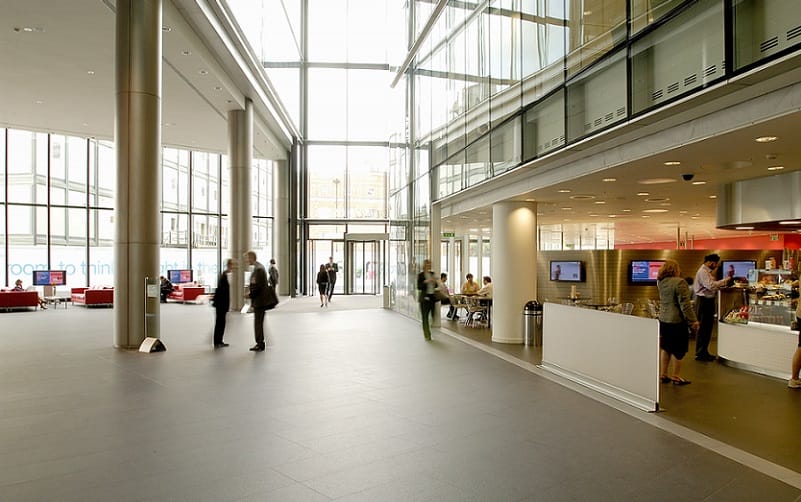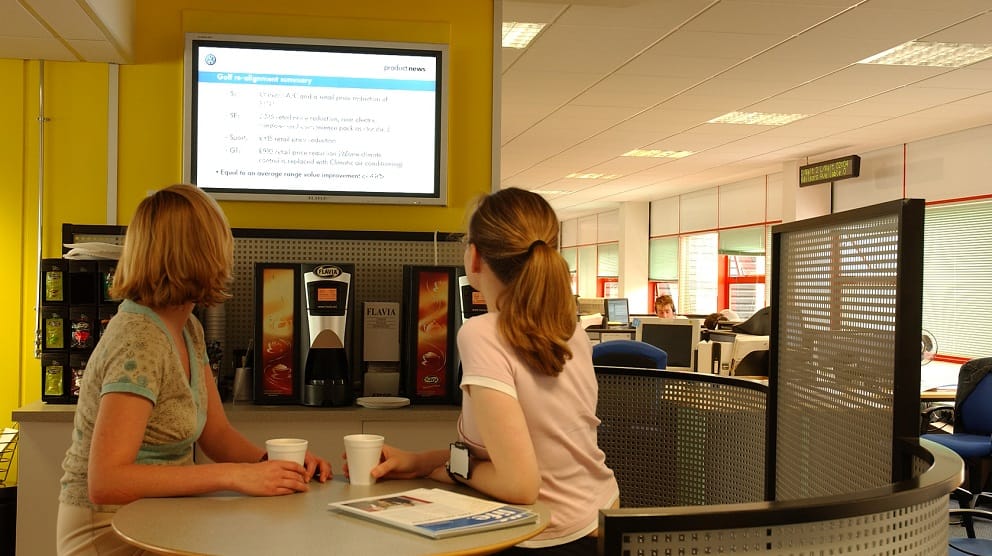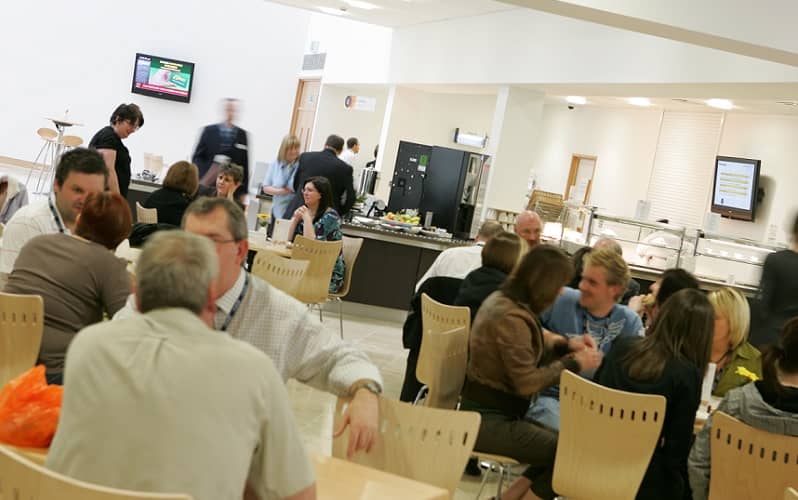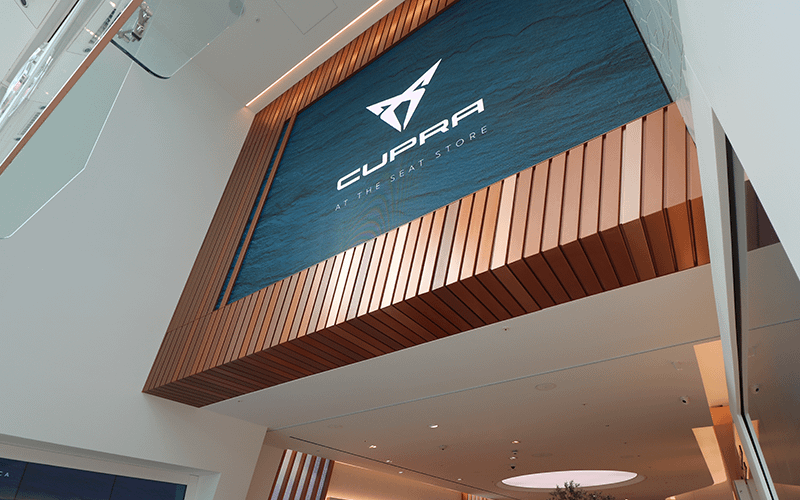Enterprise Digital Signage Project management – Ten Top Tips

Introducing digital signage to any business takes a fairly sizeable investment in time and money, but as the size of business increases, so does the complexity. That’s why digital signage project management need to be approached carefully.
Enterprise digital signage can deliver an impressive ROI. But if it’s approached with the wrong mindset, and procurement is done in the wrong way, it can cause more problems than it solves.
Enterprise-level businesses tend to have a slick procurement process for IT equipment that aims to purchase decent quality products as quickly and cost-effectively as possible. Unfortunately, this method doesn’t account for all the intricacies of digital signage.
There is a clear, set process that needs to be followed to ensure that you buy the correct hardware and software, and can get the right level of technical support to meet your business’s needs.
So here are our ten top tips to help you nail your enterprise digital signage project management.
1. Digital Signage Isn’t a One-Trick Pony
Traditional signage does one single job. Whether it’s telling someone to do something or not to do it, it can only fulfil one role at once.
All too often people take the same approach to digital signage, thinking that one display can only do one job at once. But it is infinitely more versatile, simply because of the vast amount of communication space it creates.
You’ll have the ability to change the content appearing on screens multiple times per day. You can also display different pieces of content/information on the screen at the same time. In fact, the only limit you have is the amount of content you possess, and the number of times people will have the opportunity to look at it each day.

You can give different messages to different audiences at different times of the day/week and in different areas. For example, in leisure or retail businesses, you could display internal communications information (e.g. staff notices/best practice/reminders) on all screens before your premises open to visitors, then remove or restrict them to staff-only spaces past that point.
Alternatively, you can split the screen and give people different pieces of information simultaneously, such as opening/closing times, the latest sales promotion, and any pertinent on-site health & safety guidance. Because there is such a breadth of communication possibilities, it is essential to consider all the different ways and places you could conceivably use digital signage around your business before doing anything else.
It can be difficult to fully anticipate all the potential uses you might find for digital signage. Subsequently, many enterprise-level businesses find it useful to work with a digital signage consultancy for this process, as they’ll have a broader experience of all the different applications that may be appropriate and can make suggestions.
2. Plan Your Objectives and Metrics
As we’ve said, digital signage can be a sizeable investment for an enterprise-level business. That being the case, it’s important to work out when and how you’re likely to get a return on investment from it.
Plot out clear objectives and put a value on them. Then decide what metrics you’ll use to judge how successful it is, and who will be responsible for managing and delivering them.
This will give you a decent understanding of you’re likely to get the best value for money from your digital signage, what a sensible outlay might be, and how you’re going to win support from around the board table.
This strategic information will advise your procurement and planning, giving you guidance on the types of hardware you’ll need and where it’s going to go. It will also identify the stakeholders that would need to be involved in the process.
3. Involve All The Relevant Stakeholders
It might seem like digital signage is just something you just purchase and install. But you’ll almost certainly need to involve more stakeholders than you think regarding its purchase, installation, ongoing management, and content creation.
In most cases, it’s the marketing department or internal communications team that takes responsibility for most of the ongoing management of digital signage (depending on what you’re using it for). They should be involved before anyone else, as they’ll probably be responsible for creating or vetting most of the content, so will need to identify what resource allocation is needed.
One of the most common mistakes we see with enterprise digital signage project management is leaving the IT department out of the planning process until the last minute. It’s crucial for your digital signage to integrate seamlessly with your IT systems. Any failure to take this into account can delay projects and increase the cost.
You’ll almost certainly want to involve operations and any site managers. This will ensure that any disruption on site can be managed effectively and that the right people are on-site and available when installers arrive.
Because digital signage is designed to attract attention and creates lots of opportunities to solve business problems, inevitably people in different departments will take an interest in it for their own department’s purposes.
That being the case, you may want to discuss how content from different departments is going to be produced, and which budgets it will come out of (especially if it’s being created by an agency). It’s also a good idea to identify how content from different departments will be prioritised to avoid any conflict later on.
4. Identify High-Traffic Areas
Obviously, you want your digital signage content to be seen by as many of the appropriate people as possible. This means you need to identify the areas where this is going to be most likely to happen.
Before you plan the location of your screens, you should identify which are the high-traffic areas of your site/s. Equally important is to identify which locations provide more than five seconds of dwell time, so that the maximum number of people will not only see your display but will have a chance to take it in.

Consider the flow of people and whether people gathering around a screen is likely to block/inconvenience people travelling around the building.
Also think about whether there is direct sunlight likely to shine on a screen in those areas, making it hard for people to see properly. A good digital signage consultancy will be able to help you identify any issues like this and resolve them. They will probably be able to make suggestions you won’t have thought of too (e.g. ceiling-mounted or totem digital signage).
5. Don’t Buy Your Hardware Too Soon
Sometimes, we come in on a project only to find that the customer has already bought a large amount of digital signage hardware. Occasionally, we may be able to work with it, but if they’ve not taken any advice before buying it there’s a strong possibility we won’t.
Not because we don’t want to. But for practical reasons such as the products they’ve bought aren’t compatible – a surprising amount of digital signage hardware isn’t.
Or they aren’t suitable for the locations they’re intended to be situated in. For example, being the wrong size, or being unsuitable for warm, cold, or damp areas or in places with lots of direct sunlight.
Or they don’t have the correct functionality. For effective estate management, for example, your hardware should offer remote access/management, which will allow technical issues to be diagnosed and corrected off-site. A lot of hardware doesn’t have this facility making it difficult for third parties to deliver technical support cost-effectively.
Frequently, businesses will buy what appears to be a great deal but find it’s actually what we’d consider sub-standard kit. We can try to use it, but often there are on-screen quality issues we can’t disguise. Furthermore, you’ll probably end up having to replace it sooner, and spend more on your energy bills too.
6. Or Your Software
Buying your software too soon can be just as problematic.
As with your hardware, you’ll need to know what functionality you’re going to want in the future. To do that you’ll need to know exactly who’s going to want to use it and how.
You’ll also need to know who’s going to need to access it. If your software subscription is based on the number of users you have, you may end up spending more than you intended. You’ll also want to know what management controls are needed for those users. You may want to block certain employees from changing screen displays without authorisation, which not all software packages can do.
If you’re not an experienced buyer, there are likely to be features that you’ll want but probably don’t know exist (this is where advice from a digital signage consultancy or integrator can be invaluable). For example, the ability to adjust your screens’ brightness remotely or on a timed basis to coincide with daylight hours, can be useful for extending your screens’ life. Some software products, like our own SaturnVision, can not only detect media player issues, they can also diagnose what’s causing them, making estate management much easier.

You’ll also need to consider the types of content you’ll want to play on it to ensure that your software has the correct APIs to support third-party software or app integration.
Be aware you’ll probably need technical support – especially when you’re just getting used to a new CMS (content management system) – and not all providers offer 24/7 technical support, so this is also something to check before signing up for a license.
7. Set A Realistic Budget For Your Enterprise Digital Signage Project
In any project, there’s going to be a process of fine-tuning, where you tweak your shopping list, based on new information – for example after a consultant’s site visit or following a stakeholder meeting. However, with most enterprise digital signage projects, this process tends to drag on for an unnecessarily long time.
This tends to be as a result of one of three things:
- people underestimating the cost of digital signage (usually assuming that commercial screens cost roughly the same as domestic TVs)
- people overestimating how much their business is willing to spend on digital signage
- changing business priorities
There’s not a lot you can do about changing business priorities. But you can save yourself and your consultancy time by being realistic about your plans and your budget from the start.
Set a budget and get it signed-off, in principle, internally. Give it to your consultancy or integrator with a list of your objectives in priority order. This will ensure they’re only going to come back to you with ideas that you can afford and that’ll deliver the results you really want. You’ll still need to do some fine-tuning, but you can keep it to the minimum.

Failure to do this, as we’ve seen far too many times, will see stakeholders’ time being wasted and enthusiasm waning – which often causes enterprise digital signage projects to fall apart before they’ve even got off the ground. It could also see you pay more than you need to for consultancy bills.
8. Set A Budget For Your Ongoing Digital Signage Costs
Speaking of your budget, we sometimes find that businesses assume they only have to budget for hardware purchases. The result is that they then have to find a way to cover costs they didn’t account for.
There are a few ongoing costs to plan for when you’re budgeting:
– software subscriptions
– content creation/management
– technical support
– increased energy costs
– hardware replacements
Whilst some can be handled in-house, you need to take account of the additional resource requirements that will involve. You may find that it costs you more to do things in-house than outsourcing it, simply because non-specialists will take much longer to do the work to a decent standard.
9. Get Senior Buy-In As Early As Possible
If your enterprise digital signage project is going to be successful (especially if you’re using it for the first time) you’ll need senior buy-in at an early stage. If you don’t have this, at least in principle, you’re likely to waste time later on, and your project will probably fail to get off the ground.
If it’s the first time you’re using digital signage and you’re struggling to get buy-in for a large-scale project, consider whether a pilot scheme may help. It can allow you to experiment and work out the perfect recipe and timing for your content to get the evidence of success you need to secure further investment.
10. Trust Your Digital Signage Consultancy
If you’ve never purchased digital signage before, you’ll be surprised by how much there is to know, simply because of all the different factors involved (e.g. objectives, volumes/directions of footfall, natural light, moisture, electrics, wi-fi signal etc.)
Even if you have been involved in using digital signage before, the situation you’ve used it in is unlikely to be identical to another.
A good digital signage consultancy or integrator will help you avoid making mistakes. They should also save you time and money in the long run (check out our article on how to find one) if they’re involved early enough.
When you’ve found a consultancy, avoid being too prescriptive about your hardware/software requirements with them. The more specific you are, the less chance they will have to use their previous experiences to advise you on what to aim for/avoid.
Instead, be clear about what you want to achieve, when by, and why, and what you have to spend. Also, tell them about any challenges and concerns you have, and any practical considerations. This will give them an opportunity to open a dialogue with you about your initial and ongoing needs, and to make tailored recommendations.
If you’re interested in learning how to get your digital signage project off to a good start, why not check out our articles on
Finding a good digital signage service provider
Getting a good digital signage ROI
The top 20 most common digital signage mistakes businesses make
If you have an enterprise digital signage project, get in touch with the Saturn team by phone on 0161 222 0706 or fill in the form below and we can help you to make it a success and your investment worthwhile.
Ready to make an impact?
Get in touch now for competitive prices, good advice, & slick project delivery